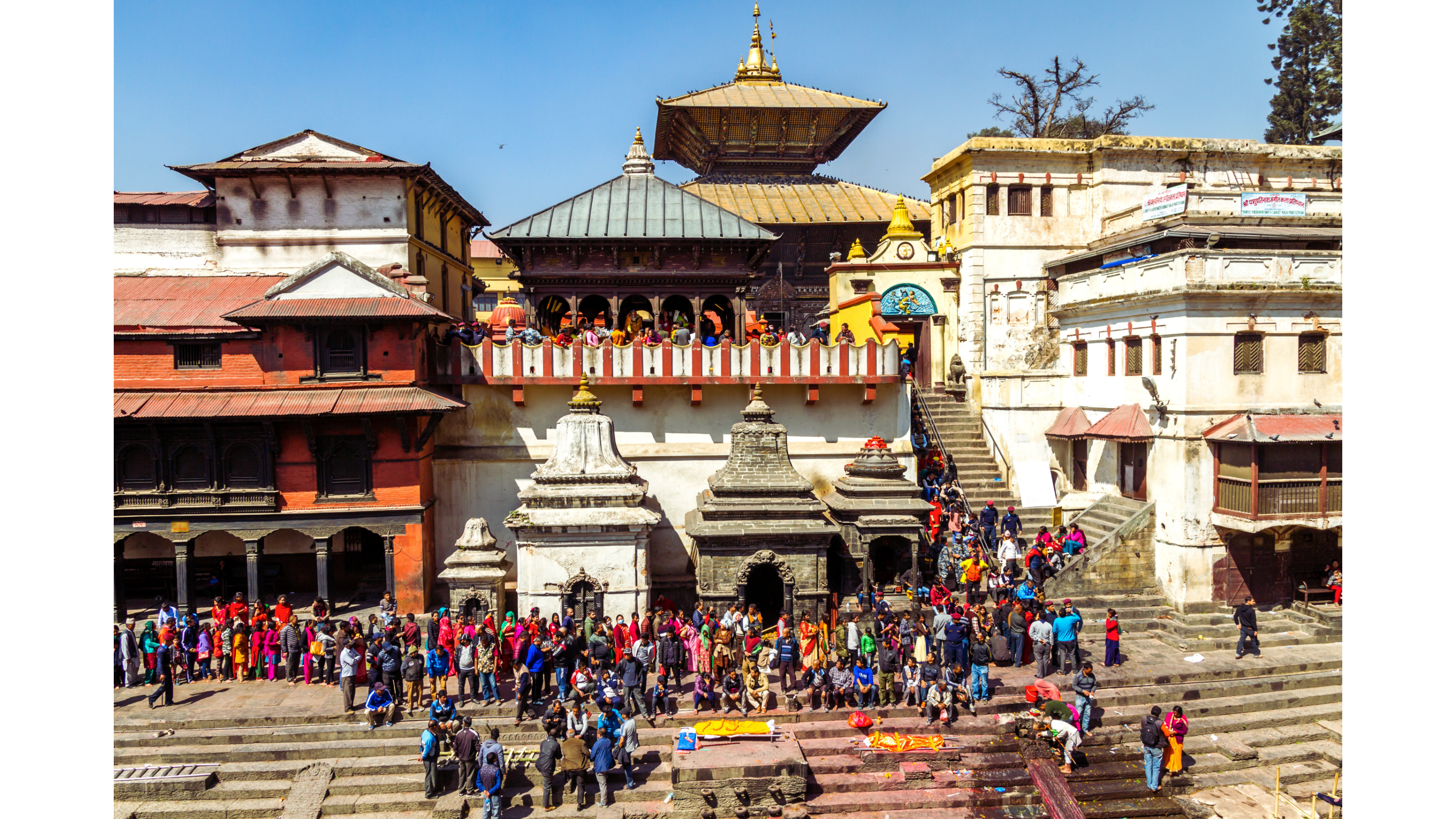
Pashupatinath Temple Nepal, a UNESCO World Heritage Site, is a sacred Hindu shrine dedicated to Lord Shiva. Located 5 km east of Kathmandu on the banks of the Bagmati River, it is revered for its spiritual significance, stunning pagoda-style architecture, and rich cultural heritage. Believed to house the head of Lord Shiva, the temple complex spans 0.64 hectares, featuring numerous shrines, ashrams, and sacred rituals. Pilgrims and tourists visit to witness the mesmerizing evening Aarati and ancient cremation ceremonies, making Pashupatinath Temple Nepal a timeless symbol of devotion and spirituality.
Table of Contents.
- Historical Significance of Pashupatinath Temple Nepal
- The Legendary Origins of Pashupatinath Temple Nepal
- The Suitable Time to Visit Pashupatinath Temple
- A UNESCO World Heritage Site
- Architectural Grandeur of Pashupatinath Temple
- Rituals and Festivals celebrated at Pashupatinath Temple
Historical Significance of Pashupatinath Temple Nepal.
Pashupatinath Temple Nepal, a UNESCO World Heritage Site, is a revered shrine dedicated to Lord Shiva. Located on the Bagmati River in Kathmandu, its origins date back to at least 400 CE. According to legend, Shiva once roamed here as a deer, leaving behind a sacred antler that became the first Shiva Lingam.
Built by Licchavi King Supuspa Dev (464-505 AD) and later reconstructed in the 17th century under Shivasimha Malla, the temple complex houses 492 shrines, sacred ghats, and a renowned cremation site. A major pilgrimage site, especially during Maha Shivaratri, it stands as a symbol of Nepal’s deep spiritual and architectural heritage.
The Legendary Origins of Pashupatinath Temple Nepal.
Pashupatinath Temple Nepal, a sacred Hindu shrine dedicated to Lord Shiva, holds immense religious, historical, and cultural significance. Located on the banks of the Bagmati River in Kathmandu, its origins date back to at least 400 CE. The pagoda-style temple features four silver-gilded doors, gold-gilded roofs, and intricate carvings of deities. The current structure dates to the 19th and 20th centuries, with contributions from the Rana rulers and King Mahendra. A UNESCO World Heritage Site since 1979, Pashupatinath Temple Nepal attracts millions of pilgrims, especially during Maha Shivaratri. Legends tell of Shiva’s presence as a deer and a divine cow revealing the first Shiva Lingam. With over 3,200 statues and multiple smaller temples, it remains a symbol of Nepal’s devotion, tradition, and architectural grandeur.
The Suitable Time to Visit Pashupatinath Temple.
Pashupatinath Temple Nepal, a revered Hindu shrine in Kathmandu, is open 24/7 for visitors to explore its outer sanctum, Bagmati River banks, and forests. The inner courtyard is open from 4 AM to 9 PM, with Shiva Lingam rituals from 5 AM to 12 PM and 5 PM to 7 PM. Abhishekam is held from 9 AM to 11 AM. The western entrance remains open year-round, while other gates open only during festivals. Hindus must carry ID proof for inner courtyard access.
Main Temple Gate Timings:
- 4 AM – 9:30 AM: Western door open
- 9:30 AM – 2 PM: All four doors open
- 2 PM – 4 PM: All doors closed
- 5:30 PM – 7 PM: All four doors open
How to Reach Pashupatinath Temple Nepal:
- By Air: Direct flights from major Indian cities to Kathmandu’s Tribhuvan International Airport.
- By Train: Trains to nearby Himalayan cities, followed by a connecting journey to Kathmandu.
- By Road: Buses and taxis from Indian cities like Darjeeling, Shimla, and Kashmir to Kathmandu.
Upon arrival in Kathmandu, taxis or autorickshaws can take you to the western entrance of the temple complex. During festivals, additional gates open for devotees to partake in celebrations.
A UNESCO World Heritage Site.
Pashupatinath Temple Nepal, a UNESCO World Heritage Site since 1979, is a cultural and spiritual treasure, renowned for its stunning pagoda-style architecture and sacred significance. Spanning a vast area along the Bagmati River, it houses numerous shrines, ashrams, and ghats, serving as a hub for religious ceremonies. The UNESCO recognition has helped preserve its rich heritage, attracting visitors worldwide to experience its divine aura. A visit to Pashupatinath Temple Nepal offers a deep connection to ancient traditions, architectural marvels, and timeless rituals, making it a journey into Nepal’s spiritual heart.
Architectural Grandeur of Pashupatinath Temple.
The Pashupatinath Temple Nepal is a stunning example of Nepalese pagoda-style architecture, featuring gilded copper roofs, intricately carved wooden rafters, and silver-plated doors. The temple houses the sacred four-faced Shiva Lingam, symbolizing his omnipresence. Surrounding the main shrine are smaller temples, ashrams, and cremation ghats along the Bagmati River, emphasizing the cycle of life and death. The temple’s grandeur, with its golden spires and mythological carvings, reflects Nepal’s rich cultural and spiritual heritage. As one of Hinduism’s holiest sites, Pashupatinath Temple Nepal remains a revered destination for devotees and visitors alike.
Rituals and Festivals are celebrated at Pashupatinath Temple.
Pashupatinath Temple Nepal is a sacred Hindu site known for its daily rituals, grand festivals like Maha Shivaratri and Teej, and cremation ceremonies at Arya Ghat. During Maha Shivaratri, thousands of devotees gather to seek Lord Shiva’s blessings through night-long prayers and offerings. Nearby, the Guhyeshwari Temple adds to its spiritual significance. Visitors can explore bustling markets, and meditation spots, and take a scenic walk to Boudhanath Stupa. Experience the divine energy of Maha Shivaratri at Pashupatinath Temple Nepal and immerse yourself in its sacred rituals. Nearby, the Guhyeshwari Temple adds to its spiritual significance. Visitors can explore bustling markets, and meditation spots, and take a scenic walk to Boudhanath Stupa. Rich in culture, history, and nature, Pashupatinath Temple Nepal remains a vital pilgrimage destination for devotees seeking divine blessings
Pashupatinath Temple is more than just a religious landmark; it is a profound symbol of Nepal’s cultural and spiritual identity. Whether you visit for devotion, architectural admiration, or cultural exploration, this sacred temple offers an unforgettable experience in the heart of Kathmandu. Plan your visit to witness Nepal’s rich heritage and spiritual traditions firsthand.
FAQs About Visiting Pashupatinath Temple
1. Where is Pashupatinath Temple located?
Pashupatinath Temple is situated approximately 5 kilometers east of Kathmandu, on the banks of the Bagmati River.
2. What makes Pashupatinath Temple so significant?
It is Nepal’s holiest Hindu temple, dedicated to Lord Shiva. The temple’s spiritual importance dates back centuries, and it remains a major site for Hindu rituals and ceremonies.
3. Can non-Hindus enter the temple?
Non-Hindus are not allowed inside the main temple but can explore the outer premises, view the temple from the opposite bank of the Bagmati River, and witness various cultural and religious activities.
4. What do the five faces of Pashupatinath Temple Nepal represent?
The five faces of Lord Shiva at Pashupatinath Temple Nepal symbolize his five divine aspects—Sadyojata (creation), Vamadeva (preservation), Aghora (destruction), Tatpurusha (concealment), and Ishana (supreme consciousness)—representing his omnipresence in all directions.
5. How did Lord Shiva get his third eye?
According to Hindu mythology, Lord Shiva gained his third eye when Goddess Parvati playfully covered his two eyes, plunging the universe into darkness. To restore balance, a fiery third eye emerged on his forehead, radiating divine energy and wisdom.
6. Are there any entry fees for visitors?
For Nepali citizens, entry is free. Foreign visitors (excluding Indians) are required to pay an entry fee, which contributes to temple maintenance and preservation.
7. What cultural practices should visitors respect?
Visitors should dress modestly, remove shoes before entering sacred areas, and refrain from photography inside the temple premises. It is also advisable to observe silence in designated meditation zones.
8. What are the best areas to stay near Pashupatinath Temple Nepal?
The best areas to stay are around Gaushala, Tilganga, Airport, and Pingalasthan, as they offer easy access to the temple and nearby attractions. For a comfortable and convenient stay, Attic Inn provides excellent hospitality near the temple.
9. How can I reach Pashupatinath Temple?
The temple is easily accessible from Tribhuvan International Airport (a 10-minute drive) or by local transportation from any part of Kathmandu.
10. What other attractions are near Pashupatinath Temple?
Nearby sites include Guhyeshwari Temple, Boudhanath Stupa, and Swayambhunath (Monkey Temple), which are also significant cultural landmarks in Kathmandu.
DEX analytics platform with real-time trading data – https://sites.google.com/walletcryptoextension.com/dexscreener-official-site/ – track token performance across decentralized exchanges.
Privacy-focused Bitcoin wallet with coin mixing – https://sites.google.com/walletcryptoextension.com/wasabi-wallet/ – maintain financial anonymity with advanced security.
Lightweight Bitcoin client with fast sync – https://sites.google.com/walletcryptoextension.com/electrum-wallet/ – secure storage with cold wallet support.
Full Bitcoin node implementation – https://sites.google.com/walletcryptoextension.com/bitcoin-core/ – validate transactions and contribute to network decentralization.
Mobile DEX tracking application – https://sites.google.com/walletcryptoextension.com/dexscreener-official-site-app/ – monitor DeFi markets on the go.
Official DEX screener app suite – https://sites.google.com/mywalletcryptous.com/dexscreener-apps-official/ – access comprehensive analytics tools.
Multi-chain DEX aggregator platform – https://sites.google.com/mywalletcryptous.com/dexscreener-official-site/ – find optimal trading routes.
Non-custodial Solana wallet – https://sites.google.com/mywalletcryptous.com/solflare-wallet/ – manage SOL and SPL tokens with staking.
Interchain wallet for Cosmos ecosystem – https://sites.google.com/mywalletcryptous.com/keplr-wallet-extension/ – explore IBC-enabled blockchains.
Browser extension for Solana – https://sites.google.com/solflare-wallet.com/solflare-wallet-extension – connect to Solana dApps seamlessly.
Popular Solana wallet with NFT support – https://sites.google.com/phantom-solana-wallet.com/phantom-wallet – your gateway to Solana DeFi.
EVM-compatible wallet extension – https://sites.google.com/walletcryptoextension.com/rabby-wallet-extension – simplify multi-chain DeFi interactions.
All-in-one Web3 wallet from OKX – https://sites.google.com/okx-wallet-extension.com/okx-wallet/ – unified CeFi and DeFi experience.

Leave a Reply